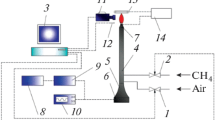Abstract
The effect of an electric field E on the structure and nitrogen oxide NOx emission of an individual laminar propane diffusion flame is experimentally investigated. The current-voltage characteristics of the flame, its deformation, the fuel-air ratio and the NOx emission are determined for positive and negative burner polarities. A reduction in NOx emission (up to 30% with respect to the emission index) is demonstrated in the case of negative burner polarity. A cause-and-effect relationship between the processes in the flame is proposed: the presence in the flame of positively charged ions and soot particles; the motion of the ions in the E field and the onset of an induced electrohydrodynamic flow directed towards the negatively charged burner; the retention and increase in the concentration of soot particles in the lower region of the flame, which leads to an increase in soot particle radiation and hence to a decrease in the temperature of the flame front and a corresponding reduction in NOx emission. The electrohydrodynamic aspects of the problem are subjected to a qualitative analysis.
Similar content being viewed by others
References
S. R. Turns and F. H. Muhr, “Oxides of nitrogen emissions from turbulent jet flames. Pt. 1. Fuel effects and flame radiation,”Combustion and Flame,87, No. 3/4, 319 (1991).
J. Lawton and F. Weinberg,Electrical Aspects of Combustion, Clarendon Press, Oxford (1969).
N. I. Kidin and V.B. Librovich, “The electric field of a laminar flame,”Fizika Goreniya i Vzryva, No. 5, 696 (1974).
T. A. Cool and P.J.H. Tjossem, “The enhancement of chemi-ionization in hydrocarbon flames by laser excited CH (A2 Δ) and CH (B2 Σ) radicals,” in: A. Fontijn (editor),Gas-Phase Chemiluminescence and Chemi-ionization, Elsevier, Amsterdam (1985), p. 105.
M. Kono, F. B. Carleton, A. R. Jones, and F. J. Weinberg, “The effect of nonsteady electric fields on sooting flames,”Combustion and Flame,78, No. 3/4, 357 (1989).
P. J. Mayo and F. J. Weinberg, “On the size, charge and number-rate of formation of carbon particles in flames subjected to electric fields,”Proc. Roy. Soc. London, Ser. A,319, No. 1538, 351 (1970).
H. G. Wagner, “Soot formation in combustion,”17th Int. Symp. on Combustion, The Combustion Institute, Pittsburgh (1979), p. 3.
E. N. Taran and V. F. Prisnyakov, “Effect of an electric field on the emission spectrum and soot formation during combustion,”The Structure of Gas Flames. Mater. 2nd Int. Seminar. Pt. 3, PTPM, Novosibirsk (1988), p. 183.
D. R. Hardesty and F.J. Weinberg, “Electrical control of particulate pollutants from flames,”14th Int. Symp. on Combustion, The Combustion Institute, Pittsburgh (1973), p.907.
M. A. Delichatsios, “Transition from momentum to buoyancy-controlled turbulent jet diffusion flames and flame height relationships,”Comb. Flame,92, No. 4, 349 (1993).
A. B. Vatazhin, V. I. Grabovskii, V. A. Likhter, and V. I. Shul'gin,Electrogasdynamic Flows [in Russian], Nauka, Moscow (1983).
Additional information
Moscow. Translated from Izvestiya Rossiiskoi Akademii Nauk, Mekhanika Zhidkosti i Gaza, No. 2, pp. 13–23, March–April, 1995.
Rights and permissions
About this article
Cite this article
Vatazhin, A.B., Likhter, V.A., Sepp, V.A. et al. Effect of an electric field on the nitrogen oxide emission and structure of a laminar propane diffusion flame. Fluid Dyn 30, 166–174 (1995). https://doi.org/10.1007/BF02029825
Received:
Issue Date:
DOI: https://doi.org/10.1007/BF02029825



